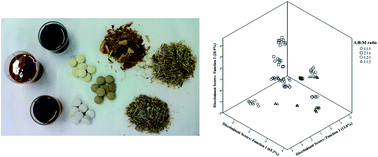New insights into the effects of formulation type and compositional mixtures on the antioxidant and cytotoxic activities of dietary supplements based-on hepatoprotective plants
Abstract
Artichoke (A), borututu (B) and milk thistle (M) are included in several supplements to provide beneficial effects. Different formulations (infusions, pills and syrups), with different proportions of A, B and M (1 : 1 : 1, 2 : 1 : 1, 1 : 2: 1, 1 : 1 : 2) within each formulation, were assayed to optimize the desired benefits. The antioxidant activity, anti-hepatocellular carcinoma activity, hepatotoxicity and bioactive compound contents were evaluated. Syrups tended to be the formulation with highest antioxidant activity and total phenolic and flavonoid content; otherwise, pills were the worst formulation. In what concerns A : B : M ratios, the results did not reveal so pronounced differences. None of the assayed mixtures resulted to be toxic (up to the maximum assayed dose) for liver primary cells (PLP2), but some samples, especially infusions, showed toxicity for the hepatocellular carcinoma cell line (HepG2). With no exception, the mixtures for all formulations showed synergistic effects on antioxidant activity, when compared to the activity of single plants.


 Please wait while we load your content...
Please wait while we load your content...